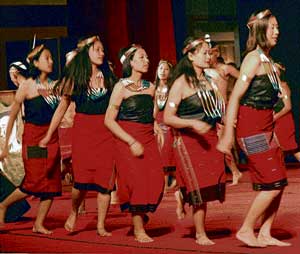Umang Hutheesing draws from his family’s royal costume collection to create a bridal line that, he says, is not ‘fashion’.
Umang Hutheesing isn’t too amused when people look at the embroidery on his designs and say, “Oh, this is zardozi,” or “This is gota.” “This is karchob,” he emphasises, “It was done during Mughal times.” The scion of the grand Hutheesing family of Ahmedabad, who now heads the Hutheesing Design Company founded by ancestor Magganbhai Hutheesing in 1881, happens to be in possession of what’s one of the largest collections of royal/ ancient costumes in India, ranking somewhere beside that at the Calico Museum in Ahmedabad and the TAPI (Textiles and Art of the People of India) in Surat — interestingly, all in Gujarat. Read, around 2000 pieces that include everything from late Mughal cotton costumes to clothes from Rajputana, Central India, Bengal, Kashmir, Mysore, Hyderabad, Kancheepuram and Kutch. This covers royal costumes, nomadic costumes and clothes from tribes like the Todas, Nagas, Rabaris, Banjaras. “It’s a reasonably well-established collection. A lot inherited, a lot collected — consciously collected by my parents, grandparents,” says Umang. Parts of the Hutheesing collection are now housed at the Metropolitan Museum of Art in New York, Tiffany’s (with which the family had a three-decade-long partnership) and the Brooklyn Museum. So, when, in 2010, he decided to bring out a commercial collection, the template was available on hand. […]
Umang had showcased the original collection in Paris in 2010 (to open the year of India in France), the restoration of which was entrusted to the master craftsmen earlier employed in the poshak khanas of Ahmedabad. “It is not like this work can be done in any embroidery workshop. These are craftsmen who worked for the royal families. With the royal patronage gone, most of them remain unemployed because to produce them is necessarily, by definition, expensive. These are palace crafts. They were master craftsmen and they are unique — it’s like palace architecture. I employ only craftspeople to restore my original collection, but that’s not the only way to keep them employed 365 days. And I started producing this new collection, to keep them employed. And they don’t have to work in restaurants and coffee shops…” […]
“People should remember that even Akbar’s poshak khana was not in Delhi; it was in Ahmedabad. Throughout the Mughal rule, all their clothes were made in Ahmedabad and Lahore. And then the legacy continued. India had 560-odd royal families, of which almost 300 were in Gujarat. So there was so much patronage in Gujarat. And also the temples. Embroidery was also done in Jain temples. It was for the God and the maharaja; it never entered the larger public domain.” Until now, he means to say.
Umang has also started a foundation called India Smiling, under which 500 children of craftspeople have been adopted and their medical expenses and education provided for.
While selling in a multi-label fashion boutique, Umang maintains he’s a revivalist and not a fashion designer. […]
The collection, he says, is his story and that of his family. “My inspiration doesn’t come from the sun and the moon and the Taj Mahal. My inspiration comes from my own family. I’m not going to create stories. […]
Source: Looking at the bride side | SHALINI SHAH, The Hindu, NEW DELHI, January 30, 2013
Address : https://www.thehindu.com/features/metroplus/fashion/looking-at-the-bride-side/article4361186.ece
Date Visited: 4 December 2020
[Bold typeface added above for emphasis]
Up-to-date reports by Indian journalists and commentators
To search Indian periodicals, magazines, web portals and other sources safely, click here. To find an Indian PhD thesis on a particular tribal community, region and related issues, click here >>
Search tips
Combine the name of any particular state, language or region with that of any tribal (Adivasi) community.
Add keywords of special interest (music, poetry, dance just as health, sacred grove and biodiversity); learn about the rights of Scheduled Tribes such as the “Forest Rights Act” (FRA); and the United Nations “Declaration on the Rights of Indigenous Peoples”, “Universal Declaration of Human Rights”, “women’s rights”, or “children’s right to education”.
Ask a question that includes “tribal” or “Adivasi”, for instance: “Adivasi way of life better?” (or “tribal way of life worse?”)
Specify any particular issue or news item (biodiversity, bonded labour and human trafficking, climate change, ecology, economic development, ethnobotany, ethnomedicine, global warming, hunter-gatherers in a particular region or state, prevention of rural poverty, water access).
For official figures include “scheduled tribe ST” along with a union state or region: e.g. “Chhattisgarh ST community”, “Himalayan tribe”, “Scheduled tribe Tamil Nadu census”, “ST Kerala census”, “Particularly Vulnerable Tribal Group Jharkhand”, “PVTG Rajasthan”, “Adivasi ST Kerala”, “Adibasi ST West Bengal” etc.
In case the Google Custom Search window is not displayed here try the following: (1) toggle between “Reader” and regular viewing; (2) in your browser’s Security settings select “Enable JavaScript” | More tips >>
Note: hyperlinks and quotes are meant for fact-checking and information purposes only | Disclaimer >>

by Anthony Kuriakose © Deccan Herald >>
Learn more about Naga cultural heritage >>
Learn more
Crafts and visual arts | Fashion and design | Masks
eBooks, eJournals & reports | eLearning
eBook | Background guide for education
Forest dwellers in early India – myths and ecology in historical perspective
Himalayan region: Biodiversity & Water
History | Hunter-gatherers | Indus Valley | Megalithic culture | Rock art
Languages and linguistic heritage
Modernity | Revival of traditions
Tribal Research and Training Institutes with Ethnographic museums
Tips for using interactive maps
Toggle to normal view (from reader view) should the interactive map not be displayed by your tablet, smartphone or pc browser
For details and hyperlinks click on the rectangular button (left on the map’s header)
Scroll and click on one of the markers for information of special interest
Explore India’s tribal cultural heritage with the help of another interactive map >>
